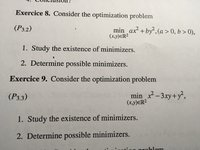malekhammou
New member
- Joined
- Oct 24, 2020
- Messages
- 3
Hello Everyone
In one of my assignments, I am asked to study the existence of possible minimizers and finding possible ones for an optimization problem represented by a function f (Find attached the statement of the exercise). I proceeded by finding the points where the gradient is equal to zero and where the Hessian is definite positive.
I am wondering if you could possibly provide help and guidance.

